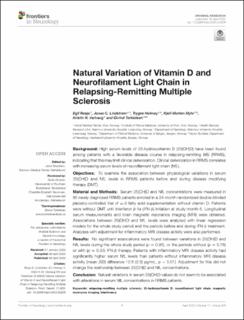| dc.contributor.author | Røsjø, Egil Rørvik | |
| dc.contributor.author | Lindstrøm, Jonas Christoffer | |
| dc.contributor.author | Holmøy, Trygve | |
| dc.contributor.author | Myhr, Kjell-Morten | |
| dc.contributor.author | Varhaug, Kristin Nielsen | |
| dc.contributor.author | Torkildsen, Øivind Fredvik | |
| dc.date.accessioned | 2021-07-05T07:47:36Z | |
| dc.date.available | 2021-07-05T07:47:36Z | |
| dc.date.created | 2021-01-21T12:55:24Z | |
| dc.date.issued | 2020-04-30 | |
| dc.Published | Frontiers in Neurology. 2020, . | |
| dc.identifier.issn | 1664-2295 | |
| dc.identifier.uri | https://hdl.handle.net/11250/2763280 | |
| dc.description.abstract | Background: High serum levels of 25-hydroxyvitamin D (25(OH)D) have been found among patients with a favorable disease course in relapsing-remitting MS (RRMS), indicating that this may limit clinical deterioration. Clinical deterioration in RRMS correlates with increasing serum levels of neurofilament light chain (NfL).
Objectives: To examine the association between physiological variations in serum 25(OH)D and NfL levels in RRMS patients before and during disease modifying therapy (DMT).
Material and Methods: Serum 25(OH)D and NfL concentrations were measured in 85 newly diagnosed RRMS patients enrolled in a 24-month randomized double-blinded placebo-controlled trial of ω-3 fatty acid supplementation without vitamin D. Patients were without DMT until interferon β-1a (IFN-β) initiation at study month 6. Longitudinal serum measurements and brain magnetic resonance imaging (MRI) were obtained. Associations between 25(OH)D and NfL levels were analyzed with linear regression models for the whole study period and the periods before and during IFN-β treatment. Analyses with adjustment for inflammatory MRI disease activity were also performed.
Results: No significant associations were found between variations in 25(OH)D and NfL levels during the whole study period (p = 0.95), or the periods without (p = 0.78) or with (p = 0.33) IFN-β therapy. Patients with inflammatory MRI disease activity had significantly higher serum NfL levels than patients without inflammatory MRI disease activity [mean (SD) difference 12.6 (2.0) pg/mL, p < 0.01]. Adjustment for this did not change the relationship between 25(OH)D and NfL concentrations.
Conclusion: Natural variations in serum 25(OH)D values do not seem to be associated with alterations in serum NfL concentrations in RRMS patients. | en_US |
| dc.language.iso | eng | en_US |
| dc.publisher | Frontiers | en_US |
| dc.rights | Navngivelse 4.0 Internasjonal | * |
| dc.rights.uri | http://creativecommons.org/licenses/by/4.0/deed.no | * |
| dc.title | Natural Variation of Vitamin D and Neurofilament Light Chain in Relapsing-Remitting Multiple Sclerosis | en_US |
| dc.type | Journal article | en_US |
| dc.type | Peer reviewed | en_US |
| dc.description.version | publishedVersion | en_US |
| dc.rights.holder | Copyright the authors | en_US |
| dc.source.articlenumber | 329 | en_US |
| cristin.ispublished | true | |
| cristin.fulltext | original | |
| cristin.qualitycode | 1 | |
| dc.identifier.doi | 10.3389/fneur.2020.00329 | |
| dc.identifier.cristin | 1876523 | |
| dc.source.journal | Frontiers in Neurology | en_US |
| dc.relation.project | Norges forskningsråd: 288164 | en_US |
| dc.identifier.citation | Frontiers in Neurology. 2020, 11, 329. | en_US |
| dc.source.volume | 11 | en_US |

